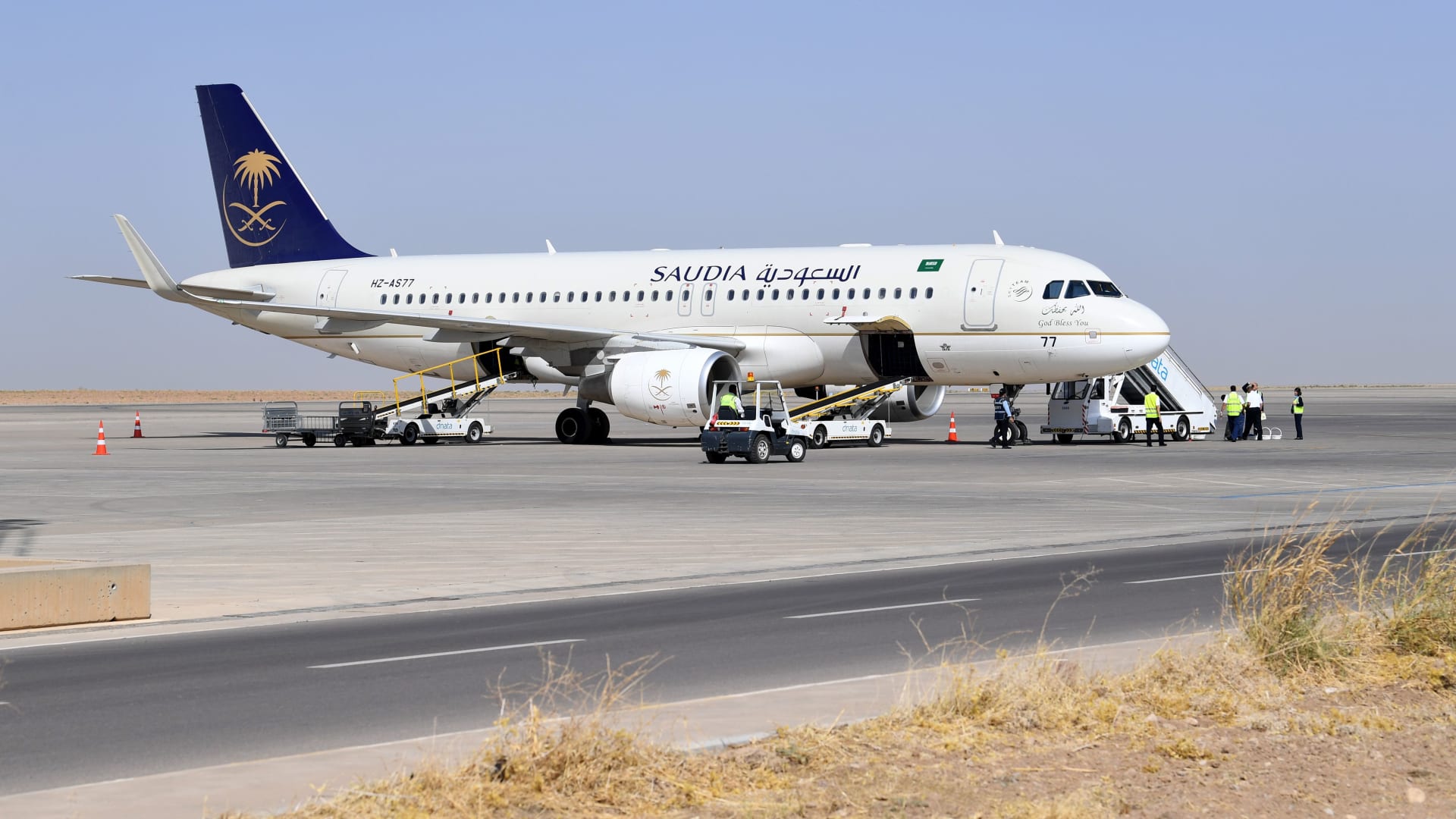Home » Saudi Arabia » Malham Airport Joins KSA’s General Aviation Services Realising Vision 2030
Business
Malham Airport Joins KSA’s General Aviation Services Realising Vision 2030
Published
3 days agoon
By
Huda Az
The General Authority of Civil Aviation (GACA) has designated Malham Airport in Riyadh, the capital, as a specialised general aviation airport. This calculated action supports the Kingdom’s efforts to solidify its position as a major international aviation hub and aligns with the goals of Saudi Vision 2030.
Moreover, this announcement helps to diversify the economy and promote sustainable growth by opening up new opportunities for luxury travel, business tourism, and private aircraft. It also constitutes a qualitative addition to the Kingdom’s sophisticated aviation infrastructure.
Location & Modern Design
Malham Airport, located in Riyadh’s Al-Khair neighbourhood, is strategically situated near King Fahd Road and the northern Al-Tuwaiqi Road. Its proximity to important venues like the Falcon Exhibition and Riyadh International Convention and Exhibition Centre makes it an ideal starting point for VIPs and business travellers attending significant events.
Likewise, with a total area of over 140,000 square meters, the airport can accommodate a wide range of operations and offer integrated services that meet the highest standards. The ambitious aim of the state-of-the-art facility’s construction was to handle more than 25,000 flights annually.
The airport’s significant infrastructure investment is crucial in meeting the increasing demand for public and private aviation services in Saudi Arabia. This is particularly significant for customers seeking speed and flexibility and businesses relying on private aviation for regional and global expansion and commercial operations.
The General Authority of Civil Aviation’s official spokesperson, Ms. Ibtisam Al-Shehri, clarified in a media statement that Malham Airport, which is situated near the World Defence Show, will mainly serve general aviation flights in this regard. She noted that this category of aviation encompasses unplanned flights for private aircraft, such as business jets and VIP aircraft, as well as chartered aircraft upon request. The regular and scheduled commercial airline flights, which depend on ticket sales and use the Kingdom’s major airports, are not the same as this.
Besides, Al-Shehri confirmed that the airport will commence after obtaining necessary licences, approvals, and procedures in consultation with relevant authorities and will be implemented using an efficient partnership model, aligning with the Kingdom’s strategy to boost private sector involvement.
Read more: “A Plane from History” A Book Chronicles Saudi Aviation’s History
Airport Objectives: The Role in the General Aviation Roadmap
Malham Airport’s privatisation is a crucial implementation step in the “General Aviation Roadmap 2030,” which GACA is pursuing to meet its lofty objectives. By building an integrated network of general aviation airports throughout the Kingdom, this roadmap hopes to draw in private aircraft operators and integrated service providers and foster an alluring investment climate for this crucial industry.
With this strategic move, GACA hopes to accomplish several important goals, chief among them being the promotion of economic growth through the provision of an outstanding facility that boosts private aviation traffic and facilitates commercial and tourism endeavours.
Additionally, it seems likely that the new airport will help localise the aircraft maintenance, repair, and overhaul (MRO) sector. This will decrease dependency on outside services, improve local capabilities in this crucial technical area, and provide national cadres with high-quality employment opportunities. This supports the overarching objective of expanding the infrastructure of the aviation industry generally to satisfy rising demand and draw in top-tier investments from renowned domestic and international businesses that operate and maintain private aircraft.
The General Authority of Civil Aviation (GACA) and Saudi leadership acknowledge the growing significance of the general aviation industry as a vital element in sustaining contemporary, diverse economies. In addition to offering businesses and individuals unmatched mobility flexibility, this industry successfully connects various areas, particularly those that may not be frequently serviced by commercial aviation networks.
Read more: The “Alfursan Saudia” Program: How Do You Sign up For it?
Strategic Importance
The goals of Saudi Vision 2030, which include diversifying the country’s revenue streams and increasing the GDP contribution of non-oil industries like aviation, tourism, and logistics, are closely related to this trend.
The general aviation industry has a huge amount of potential; according to the GACA, it could boost the private sector’s GDP contribution to about $2 billion by 2030, which is multiple times its current amount. Malham Airport’s anticipated contribution to easing operational strain at King Khalid International Airport (KKIA) in Riyadh is one of the major operational advantages of privatisation.
KKIA, one of the busiest airports in the area, can improve the operational efficiency of scheduled commercial flights and alleviate runway and parking area congestion by diverting a sizeable amount of private aircraft traffic away from the main airport. Establishing a specialised, integrated facility for general aviation will help achieve this.
KKIA’s record 269,000 flights from Riyadh to 113 domestic and international locations last year carried over 37 million passengers and handled 24 million pieces of luggage, demonstrating the enormous volume of operations it manages.
Read more: The Ten Busiest International Airports in 2023: Dubai is on Top
A More Comprehensive Plan
The role of the General Authority of Civil Aviation (GACA) extends beyond infrastructure provision. To develop new services and raise the calibre of current ones, it consistently seeks to provide businesses in the general aviation industry with alluring investment opportunities. This entails examining and revising rules to make things easier for private aircraft owners and charter operators, increasing the Kingdom’s appeal as a regional hub for general aviation operations.
In recent years, Riyadh’s aviation scene witnessed a dramatic change as a result of a large increase in airport construction and passenger terminal development to accommodate the city’s expanding population as well as the number of tourists and pilgrims. Apart from the general aviation Malham Airport and the historic King Khalid International Airport, which originally opened in 1983, there are plans to build the massive King Salman International Airport.
Further, Saudi Crown Prince Mohammed bin Salman bin Abdulaziz announced the launch of the master plan for this ambitious airport in November 2022. He intends to make Riyadh a global gateway and destination for transportation, trade, and tourism, as well as a bridge connecting East and West, thereby consolidating the Kingdom’s position as a pivotal global logistics centre.
The current King Khalid Airport terminals, six runways; and support, logistics, residential, entertainment, and commercial facilities occupying 12 square kilometres make up the estimated 57 square kilometres of King Salman International Airport, which is anticipated to rank among the world’s largest airports.
Read more: ‘Electronic Visa Waiver’ Brings 200 Saudis Back from UK Airports
Global Standards for Major Events
Riyadh is not the only city experiencing development. The Airports Holding Company (MATARAT) oversees the 27 airports that make up the Saudi airport network, which is constantly growing and accomplishing amazing feats on a global scale.
The Skytrax World Airport Report 2025 gave the Kingdom’s airports prestigious rankings. In addition to winning major accolades like “Best Airport Staff in the Middle East” and “Best New Airport Lounge in the World” for its private executive lounge, King Khalid International Airport in Riyadh shot up to 24th place in the world.
The General Authority of Civil Aviation (GACA), which assesses performance using 11 specific criteria, such as wait times and the calibre of services offered to passengers, also frequently places Saudi airports at the top of its performance reports. Among international airports with an annual passenger capacity of more than 15 million, Riyadh Airport attained an 82% compliance rate.
Furthermore, strong support for the Kingdom’s hosting of significant international events is indicative of the Saudi airport infrastructure’s high degree of preparedness. With plans to outfit 16 international airports to handle millions of tourists and fans and make it easier for them to travel between host cities, the 2034 FIFA World Cup bid emphasises this.
The airports on this list, like NEOM, Arar, and Jizan airports, have demonstrated their high operational efficiency and have received full compliance rates in the Authority’s most recent performance evaluations. The growth of the aviation industry supports the growth of other infrastructure, including the enlargement of sports stadiums and the building of new facilities, demonstrating an all-encompassing and integrated development vision.
Read more: The Saudi PIF Partially Acquires Heathrow Airport

Sindalah: Luxury Cruising Tourism in KSA

Malha Abdullah, Dean of the Saudi Theatre: The Crown Prince is the Vision’s Creator and Innovator, and there are Opportunities to See a Theatre Beneath Every Rock

Malham Airport Joins KSA’s General Aviation Services Realising Vision 2030

Ahmed Al-Badr the Saudi Businessman

Saudi Designers Ladies’ Role in the Fashion Revival & Vision 2030








